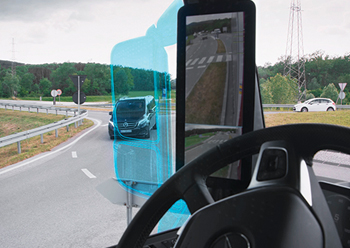
Actros with MirrorCam ... by eliminating the classic mirror, it provides a full view through the side window. The marked area illustrates the visual gain.
Actros offers a new perspective of the rear
01 May 2020
Mercedes-Benz Trucks’ new Actros is easy to recognise at first glance due to the missing rear-view and wide-angle mirrors; instead it features cameras on the roof frame and displays at the A-pillars.
The advantages of the new system are obvious – lower fuel consumption due to improved aerodynamics and increased traffic safety thanks to better visibility, says a spokesman for Mercedes-Benz Trucks, a subsidiary of Daimler.
The sustainably improved aerodynamics and safety provided by the introduction of the MirrorCam in the new Actros is one of the reasons why the vehicle won the title International Truck of the Year 2020 presented annually by Europe’s leading commercial vehicle journalists, he adds.
“Thanks to the MirrorCam, the driver now has an unobstructed view where the rear-view and wide-angle mirrors previously covered large areas to the right and left of the A-pillar – which is an advantage especially at junctions, when manoeuvring and in tight bends. And, the driver must no longer look as far to the right or left to see traffic to the rear,” he elaborates.
Also, mirrors are mounted in a fixed position so that when turning the corner the driver may lose sight of the end of the semitrailer. In contrast, the MirrorCam swivels the image of the camera mounted toward the inside of the bend, so that the driver always has the end of the trailer in view.”
For the transport company, the optimised aerodynamics can reduce fuel consumption: the optimised wind resistance thanks to MirrorCam can result in up to 1.5 per cent less fuel.
Also while misted or dirty mirror glass and side windows have always been a problem, the camera is positioned high up on the vehicle, and features a small roof above the camera lens, a special coating and the digital transmission of the image to a display in the cab, which means the system is hardly affected by misting and dirt.
The display of the MirrorCam system shows distance indicator lines which help drivers to estimate the distances behind the truck. “Three fixed lines are shown together with a line that the driver can adjust precisely to mark the end of the vehicle before starting a journey. Used in combination with the information shown in the displays by the assistance systems, the driver can now better assess three typical situations in particular: if he is evaluating whether there is sufficient distance to move out to the left; what is the distance at the rear of the vehicle; and after overtaking, when can he safely merge to the right again.
So how is the camera system’s performance at dusk or at night?
“The light transmission of the cameras is high. Thus, the displays show an image that is much brighter than the natural light. So drivers receive better information about their surroundings than with a mirror. Furthermore, the brightness is adjusted to the prevailing light conditions steplessly – drivers are not dazzled. All of that works both on the open road and in tunnels. If it is completely dark outside, the MirrorCam can only show the areas illuminated by the vehicle itself – just like a conventional mirror. Here, for maximum image information, the developers have selected a set-up which, at present, may cause a little image noise,” the spokesman explains.
Adjusting the brightness of displays is simply done via the right-hand touchscreen display or the multifunction steering wheel. If required the brightness of the right-hand and left-hand display can be adjusted differently.
Incorrectly adjusted mirrors are a potential source of danger as when drivers change their sitting position, the area that they can see changes too. For the MirrorCam, this is fundamentally different: Thanks to the camera/screen combination the driver always sees the same image – in every sitting position. The field of vision can also be set individually using the door operating unit.
The spokesman does admit that some drivers initially may find it difficult to reverse in a straight line using the MirrorCam. “This is because the MirrorCam offers two views when manoeuvring backwards: in the standard setting, the large main display shows the area directly around the truck and the lower section, the further surroundings. This view proves its value particularly when the driver reverses around a bend. However, if the driver is reversing in a straight line, it is often better to deactivate this function. This is very simple to do – just use the button in the door operating unit. Thus manoeuvring with MirrorCam offers further possibilities in comparison to mirrors. For this very reason, the system takes a little getting used to. Also the cameras are located somewhat further beyond the outer edges of the vehicle than mirrors, whereby more can be seen than with mirrors when reversing the vehicle in a straight line,” he elaborates.
When drivers spend their breaks in the cab, they can also activate the camera system for two minutes using a switch by the bed and on the co-driver’s side when the engine is switched off and the curtains are drawn. The area surrounding the vehicle is thus in view as well as any suspicious activity involving the truck or its load. The system starts automatically when the door is opened – so that exiting the vehicle is safe at all times.
- Driver-focused
- Renault Trucks gears up to resume production
- Actros offers a new perspective of the rear
- CAT commands ‘largest market share’
- Doosan Infracore wins major Saudi order


